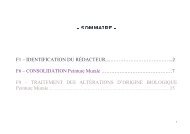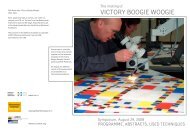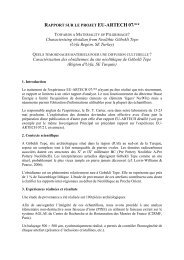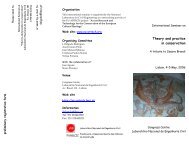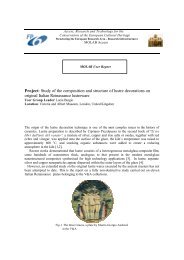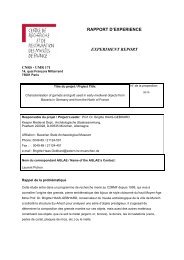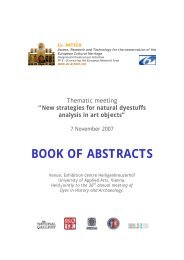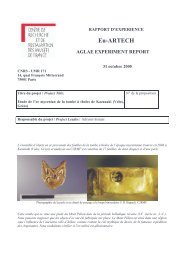JRA2 Progress report on IR multispectral imaging - Eu-ARTECH
JRA2 Progress report on IR multispectral imaging - Eu-ARTECH
JRA2 Progress report on IR multispectral imaging - Eu-ARTECH
Create successful ePaper yourself
Turn your PDF publications into a flip-book with our unique Google optimized e-Paper software.
TH<strong>IR</strong>D ANNUAL REPORT - DELIVERABLE N. 27<br />
<str<strong>on</strong>g>JRA2</str<strong>on</strong>g> – New methods in diagnostics: Imaging and<br />
spectroscopy<br />
<str<strong>on</strong>g>Progress</str<strong>on</strong>g> <str<strong>on</strong>g>report</str<strong>on</strong>g> <strong>on</strong> <strong>IR</strong> <strong>multispectral</strong> <strong>imaging</strong> - <strong>IR</strong><br />
transparency and system assembling<br />
<strong>Eu</strong>-<strong>ARTECH</strong><br />
Access, Research and Technology for the c<strong>on</strong>servati<strong>on</strong><br />
of the <strong>Eu</strong>ropean Cultural Heritage<br />
Integrating Activity<br />
implemented as<br />
Integrated Infrastructure Initiative<br />
C<strong>on</strong>tract number: RII3-CT-2004-506171<br />
Project Co-ordinator: Prof. Brunetto Giovanni Brunetti<br />
Reporting period: from June 1 st 2005 to May 31 st 2006<br />
Project funded by the <strong>Eu</strong>ropean Community<br />
under the “Structuring the <strong>Eu</strong>ropean Research Area”<br />
Specific ProgrammeResearch Infrastructures acti<strong>on</strong><br />
1
DELIVERABLE n.27<br />
<str<strong>on</strong>g>JRA2</str<strong>on</strong>g>- <str<strong>on</strong>g>Progress</str<strong>on</strong>g> <str<strong>on</strong>g>report</str<strong>on</strong>g> <strong>on</strong> <strong>IR</strong> <strong>multispectral</strong> <strong>imaging</strong> - <strong>IR</strong> transparency and system<br />
assembling<br />
Subtask 2.3- Assembling of n<strong>IR</strong> <strong>imaging</strong> equipments - Development of two new<br />
complementary N<strong>IR</strong> <strong>imaging</strong> spectroscopy methods.<br />
Subtask 2.4 Evaluati<strong>on</strong> of the device<br />
Resp. : OADC<br />
During this <str<strong>on</strong>g>report</str<strong>on</strong>g>ing period, the set-up of the prototypical form of the spectrograph (already<br />
developed and described in the previous <str<strong>on</strong>g>report</str<strong>on</strong>g>s) c<strong>on</strong>tinued with adjustments of the<br />
alignments of the various optical comp<strong>on</strong>ents. The performances were improved.<br />
The measurements <strong>on</strong> the various samples, already developed in the previous periods, also<br />
c<strong>on</strong>tinued.<br />
In Appendix 2 of the present Annex 14, are <str<strong>on</strong>g>report</str<strong>on</strong>g>ed most of the spectra that have been<br />
recorded during the last six m<strong>on</strong>ths.<br />
Subtask 2.1 - Preparati<strong>on</strong> and characterisati<strong>on</strong> of standards of layered painting materials<br />
and Subtask 2.2- Transmissi<strong>on</strong> and reflecti<strong>on</strong> of <strong>IR</strong> radiati<strong>on</strong> <strong>on</strong> layered standards<br />
Within the period between the 12 th and the 24 th m<strong>on</strong>th special reference samples were<br />
developed <strong>on</strong> wooden panels of gradually higher paint layer thickness in order to<br />
study the transmissi<strong>on</strong> and reflecti<strong>on</strong> of the <strong>IR</strong> radiati<strong>on</strong> through them. The way that<br />
these reference samples are created is displayed in figure 1.1a. Multi-spectral spectra<br />
of these samples will be acquired in the visible, near infrared (n<strong>IR</strong>) and mid infrared<br />
(m<strong>IR</strong>) area of the spectrum (up to 4500nm).<br />
Figure 1.1a: Reference sample (way of fabricati<strong>on</strong> of gradually higher thickness )<br />
The reference samples are painted <strong>on</strong> a comm<strong>on</strong> white ground and with the same binding medium in<br />
order to minimize the uncertainty to our applied algorithms during the tests.<br />
Ground : CaCO3 + animal glue<br />
Binding Medium : Egg yolk<br />
In appendix 1 all the first testing measurements <strong>on</strong> the panels are provided. For the<br />
time being the Perkin ELMER lambda 900 spectrophotometer was used in the<br />
wavelength range of 200nm-2400nm. These measurements will serve as a reference<br />
2
for the testing of the device under development. Within the next m<strong>on</strong>ths and after the<br />
first assembly of the device, the measurements will be performed using the new device<br />
and the new developed method will be tested in the extensive wavelength range<br />
between 800nm and 4500nm.<br />
Materials and methodology of creati<strong>on</strong> of the reference panels (standards)<br />
Samples of pigments in paint layers of gradually higher thickness.<br />
The panels with samples of different (gradually higher) thickness were prepared in successive<br />
steps, as follows: first, all eight parts of <strong>on</strong>e pigment sample were painted at <strong>on</strong>ce in 2 or 3<br />
layers of paint, then <strong>on</strong>e part was masked out and the remaining seven layers were painted<br />
again in 2 or 3 layers. Then two parts were masked and the remaining six were painted, and so<br />
forth. Between each step, the paint was allowed to dry satisfactorily. The panels were setaside<br />
for a m<strong>on</strong>th to dry well before the first measurements are taken.<br />
The panels for the samples of different thickness were prepared by lightly scoring rectangles,<br />
separated in 8 parts each of 2x5cm. These were then split in two lengthwise, <strong>on</strong>e half painted<br />
in 3 layers of carb<strong>on</strong> black with egg as a binding medium and the other scored in pencil with<br />
diag<strong>on</strong>al lines, again <strong>on</strong> half of its area.<br />
Figure 1.1.2a: Samples of 10 pigments in paint layers of gradually higher thickness.<br />
3
Subtask 2.3: Assembling of n<strong>IR</strong> spectroscopic <strong>imaging</strong> equipment<br />
Descripti<strong>on</strong> of the overall developed system<br />
The system will be capable of acquiring spectra in diffuse reflectance mode from<br />
800nm up to 4500nm. This is a wavelength area that is not examined extensively up<br />
to now in the field of artworks materials identificati<strong>on</strong> using <strong>IR</strong> radiati<strong>on</strong> (<strong>imaging</strong> or<br />
spectroscopy in diffuse reflectance mode).<br />
The aim is the generati<strong>on</strong> of mapping images of a Regi<strong>on</strong> Of Interest (ROI) or the<br />
whole painting as far as the materials distributi<strong>on</strong> is c<strong>on</strong>cerned. The UV –Vis -n<strong>IR</strong><br />
spectral area is extensively examined. Using the device that will be assembled, the<br />
spectral area of examinati<strong>on</strong> will extended up to 4500nm. The basic idea of the<br />
interferometer that is widely used in the available FT<strong>IR</strong> systems will be used in order<br />
to send m<strong>on</strong>ochromatic radiati<strong>on</strong> to the measurement point. The range of the<br />
excitati<strong>on</strong> system is 680nm up to 4800nm. The overall diagram of the system is<br />
provided in fig. 1.2.1a<br />
Figure 1.2.1a: overall diagram of the system<br />
The radiati<strong>on</strong> is produced in the spectrometer using the source and the interferometer<br />
and the beam splitter. Then the beam is inserted in the fiber optic bundle. After the<br />
fiber optic bundle the beam is c<strong>on</strong>densed to the measurement area using the lens<br />
system installed <strong>on</strong> the external integrati<strong>on</strong> sphere (fig. 1.2.1.3d). The diffuse<br />
4
eflected light is collected to the detector which is also installed <strong>on</strong> the integrati<strong>on</strong><br />
shpere (fig. 1.2.1.4a)<br />
The basic characteristics of the assembled device are provided in table 3.2.2a<br />
Table 3.2.2a:<br />
Parameter Value<br />
1. Wavelength range :<br />
800-4500 nm<br />
2. Measurement Spot Size: 2-4 mm diameter depending <strong>on</strong><br />
the wavelength range<br />
3. Time of measurement (spectra 4-10 sec<br />
acquisiti<strong>on</strong> in all the wavelength range)<br />
4. Wavelength resoluti<strong>on</strong> 0,1-6,4 nm (variable)<br />
5. Parts to be assembled (brochures with<br />
technical specs)<br />
5.1. MCT HgCdTe detector TE 800-4500nm<br />
cooled (Not Liquid Nitrogen)<br />
5.2 Matched Pre-Amplifiers<br />
5.3 Fiber optics 650nm to 5000 nm<br />
Heavy Metal Fluoride glass<br />
fibers (SG TM fiber)<br />
5.4 Integrati<strong>on</strong> Sphere (diffuse<br />
reflectance measurement)<br />
6. Drivers of the system, libraries in<br />
Visual Studio (C++ or Basic)<br />
5<br />
Remote gold integrating sphere<br />
(for diffuse reflectance<br />
measurement)<br />
Will be developed with the<br />
assembly of the system<br />
Use of a standard interferometer for a basic spectrometer:<br />
A basic N<strong>IR</strong>-m<strong>IR</strong> spectrometer; from the commercial spectrometer available either<br />
the PE Spectrum One NTS or a Nicolet N<strong>IR</strong> or a Bruker spectrometer are the<br />
preferred systems in terms of energy throughput; the M<strong>IR</strong> scanner from Oriel is very<br />
limited in energy to meet the overall goals; The PE system is finally preferred for<br />
price /performance reas<strong>on</strong>s;<br />
External Integrati<strong>on</strong> Sphere:<br />
An external integrati<strong>on</strong> sphere is the much best approach as far as wl range and<br />
signal/noise are c<strong>on</strong>cerned in order to provide the possibility to the user to perform in<br />
situ measurements. The integrati<strong>on</strong> sphere is gold coated in order to reflect the<br />
radiati<strong>on</strong> within the wavelength range of 800nm up to 4500nm.<br />
n<strong>IR</strong>-m<strong>IR</strong> fibers:<br />
The soluti<strong>on</strong>s are:<br />
1. gold coated lightpipes which are subject to low energy throughout and very high<br />
senistivity to mechanical movement,<br />
2. chalcogenide (CaF2) fibers are critical in mechanical movement and tend to break,<br />
transmissi<strong>on</strong> characteristics. They are superior to gold coated light pipes,
3. heavy metal fluorides (e.g. Zr) seem to be the most promising soluti<strong>on</strong>, as they are<br />
mechanically stable with high energy throuput, price may be a criterium;<br />
Detector:<br />
The possibilities compatible with he soluti<strong>on</strong> of the PE spectrometer were: 1. DTGS<br />
and MCT:<br />
The MCT detector shows about a 100 fold higher sensitivity than the standard DTGS<br />
detector; they are available with Peltier thermostatting without liquid nitrogen<br />
coutercooling at a justifiable price.<br />
Part of the used spectrophotometer<br />
The interferometer and the beam splitter of the Perkin Elmer Spectrum One NTS is<br />
used in order to produce the radiati<strong>on</strong> which radiates the object (fig. 1.2.1.1).<br />
Figure 1.2.1.1: The interferometer and the beam splitter of PE Spectrum One NTS<br />
that is used.<br />
6
Fiber optic bundle<br />
The <strong>IR</strong> fiber bundle optic that is used has an attenuati<strong>on</strong> curve provided in figure<br />
1.2.1.2. The material of the fiber optic is finally heavy metal Zr fluoride.<br />
Figure 1.2.1.2: Attenuati<strong>on</strong> curve of the fiber optic that is used for the<br />
n<strong>IR</strong>-m<strong>IR</strong> <strong>multispectral</strong> mapping <strong>imaging</strong> device.<br />
Integrati<strong>on</strong> sphere design and assembly<br />
The probe for in situ measurement is assembled using an integrati<strong>on</strong> sphere of<br />
gold surface in order to have the possibility to integrate the radiati<strong>on</strong> in the<br />
specified wavelengths up to 4500nm. The spot size of the probe is a circle<br />
with a diameter of 2mm approximately. This is changing while the excitati<strong>on</strong><br />
wavelength is changing. The final spot size in relati<strong>on</strong> with the wavelength is<br />
subjected to further study.<br />
The design of the integrati<strong>on</strong> sphere is displayed in Fig 1.2.1.3a-b and the final<br />
developed sphere in fig. 1.2.1.3c<br />
Figure 1.2.1.3a: Integrati<strong>on</strong> sphere that s developed and used for diffused<br />
reflectance measurements from 800nm up to 4500nm the dimensi<strong>on</strong>s are in<br />
INCHES.<br />
7
C<strong>on</strong>densing lens<br />
Figure 1.2.1.3b: Integrati<strong>on</strong> sphere that is developed and used for diffused<br />
reflectance measurements from 800nm up to 4500nm the dimensi<strong>on</strong>s are in<br />
INCHES.<br />
Figure 1.2.1.3c: Integrati<strong>on</strong> sphere that will be used for diffused reflectance<br />
measurements from 800nm up to 4500nm.<br />
Detector<br />
The diffused reflected radiati<strong>on</strong> from the measuring area will be guided to the<br />
receiving detector which is an (HgCdTe) Mercury Cadmium Telluride (MCT)<br />
detector (800nm – 4500nm) mounted <strong>on</strong> a 3-stage cooler, in a TO-3 housing<br />
<strong>on</strong> the integrati<strong>on</strong> sphere (fig. 1.2.1.4a). In figure 1.2.1.4b and c the MCT<br />
sensors technical informati<strong>on</strong> is provided (The way that the sensor is<br />
c<strong>on</strong>structed (b) and the electr<strong>on</strong>ic circuit used to calculate the amplifiers that<br />
will be used for the amplificati<strong>on</strong> of the received signal (c)). The detectivity<br />
curve of the sensor is provided in figure 1.2.1.4c (MCT-5-TE).<br />
8<br />
collimating lens
9<br />
MCT-Detector<br />
Figure 1.2.1.4a: The detector and the way that is mounted <strong>on</strong> the integrati<strong>on</strong><br />
sphere<br />
Figure 1.2.1.4b: The detector (way that the<br />
detector is c<strong>on</strong>structed<br />
Figure 1.2.1.4b: the electr<strong>on</strong>ic circuit used<br />
to calculate the matched amplifiers that will<br />
be used for the amplificati<strong>on</strong> of the received<br />
signal)<br />
Figure 1.2.1.4c: The detector sensitivity curve (800nm – 4500nm)
The sensor is interc<strong>on</strong>nected with the suitable electr<strong>on</strong>ic pre-amplifier because<br />
the sufficiency of the received power is critical (figure 1.2.1.4d).<br />
Figure 1.2.1.4d: preamplifier for the detector<br />
Initial evaluati<strong>on</strong> of the system<br />
Measurements were acquired from the already developed reference samples in order<br />
to justify the penetrati<strong>on</strong> of the radiati<strong>on</strong> to the paint layers of the artworks. The<br />
measurements were applied to the reference panel with the pigments that are painted<br />
with gradually increasing thickness (fig. 1.1.2a). The spectra that are acquired with<br />
the developed device are the same with the previous spectra acquired with the Perkin<br />
Elmer lambda 900 (provided in Appendix 1) in the overlapping area 800-2500nm.<br />
This fact ensures that the device works efficiently.<br />
The radiati<strong>on</strong> penetrates even the thickest layers since the spectra have lower<br />
reflectivity over the white background while the thickness increases. In the case of the<br />
black background the reflectivity increases while the thickness of the layer increase.<br />
These measurements are shown in appendix 2. A golden sample is also measured in<br />
order to validate the operati<strong>on</strong> of the system. The result is shown in fig. 1.2.1.5. As<br />
expected the gold has a reflectivity of almost 100% in the specific wavelength area<br />
(800nm-4500nm).<br />
In the N<strong>IR</strong> spectral regi<strong>on</strong> (800-2500 nm) overt<strong>on</strong>e and combinati<strong>on</strong> vibrati<strong>on</strong>al<br />
modes are active, whereas in the 2500-4200 nm regi<strong>on</strong> some fundamental vibrati<strong>on</strong>s<br />
can be observed. Almost all the absorpti<strong>on</strong> bands observed in the N<strong>IR</strong> arise from<br />
overt<strong>on</strong>es of functi<strong>on</strong>al groups c<strong>on</strong>taining hydrogen atoms (C-H, N-H, O-H) or<br />
combinati<strong>on</strong>s involving stretching and bending modes of vibrati<strong>on</strong> of such groups. A<br />
great degree of complexity characterizes the spectra acquired in this regi<strong>on</strong>. As a<br />
result, spectral assignments to specific vibrati<strong>on</strong>al modes are not always possible.<br />
10
Figure 1.2.1.5 Gold sample measurement (90% reflectivity)<br />
(800nm – 4500nm)<br />
11
APPENDIX 1<br />
Vertical axis (Reflectivity R%) - Horiz<strong>on</strong>tal axis Wavelengths (200-2400nm)<br />
Lead White<br />
(over Black)<br />
100<br />
90<br />
80<br />
70<br />
60<br />
50<br />
40<br />
30<br />
20<br />
10<br />
0<br />
0 500 1000 1500 2000 2500<br />
Yellow Ochre<br />
(over Black)<br />
60<br />
50<br />
40<br />
30<br />
20<br />
10<br />
0<br />
0 500 1000 1500 2000 2500<br />
Warm Ochre<br />
(over Black)<br />
50<br />
45<br />
40<br />
35<br />
30<br />
25<br />
20<br />
15<br />
10<br />
5<br />
0<br />
0 500 1000 1500 2000 2500<br />
12<br />
(over White)<br />
90<br />
80<br />
70<br />
60<br />
50<br />
40<br />
30<br />
20<br />
10<br />
0 500 1000 1500 2000 2500<br />
(over White)<br />
70<br />
60<br />
50<br />
40<br />
30<br />
20<br />
10<br />
0<br />
0 500 1000 1500 2000 2500<br />
80<br />
70<br />
60<br />
50<br />
40<br />
30<br />
20<br />
10<br />
(over White)<br />
0<br />
0 500 1000 1500 2000 2500
Red Ochre<br />
(over Black)<br />
35<br />
30<br />
25<br />
20<br />
15<br />
10<br />
5<br />
0<br />
0 500 1000 1500 2000 2500<br />
Sienna Burnt<br />
(over Black)<br />
30<br />
25<br />
20<br />
15<br />
10<br />
5<br />
0<br />
0 500 1000 1500 2000 2500<br />
Hematite<br />
(over Black)<br />
40<br />
35<br />
30<br />
25<br />
20<br />
15<br />
10<br />
5<br />
0<br />
0 500 1000 1500 2000 2500<br />
13<br />
70<br />
60<br />
50<br />
40<br />
30<br />
20<br />
10<br />
(over White)<br />
0<br />
0 500 1000 1500 2000 2500<br />
(over White)<br />
70<br />
60<br />
50<br />
40<br />
30<br />
20<br />
10<br />
0<br />
0 500 1000 1500 2000 2500<br />
60<br />
50<br />
40<br />
30<br />
20<br />
10<br />
(over White)<br />
0<br />
0 500 1000 1500 2000 2500
Caput Mortuum<br />
(over Black)<br />
70<br />
60<br />
50<br />
40<br />
30<br />
20<br />
10<br />
0<br />
0 500 1000 1500 2000 2500<br />
Umber Raw(over Black)<br />
50<br />
45<br />
40<br />
35<br />
30<br />
25<br />
20<br />
15<br />
10<br />
5<br />
0<br />
0 500 1000 1500 2000 2500<br />
Cinnabar<br />
(over Black)<br />
70<br />
60<br />
50<br />
40<br />
30<br />
20<br />
10<br />
0<br />
0 500 1000 1500 2000 2500<br />
14<br />
0.8<br />
0.7<br />
0.6<br />
0.5<br />
0.4<br />
0.3<br />
0.2<br />
0.1<br />
(over White)<br />
0<br />
0 500 1000 1500 2000 2500<br />
60<br />
50<br />
40<br />
30<br />
20<br />
10<br />
0<br />
(over White)<br />
-10<br />
0 500 1000 1500 2000 2500<br />
70<br />
60<br />
50<br />
40<br />
30<br />
20<br />
10<br />
(over White)<br />
0<br />
0 500 1000 1500 2000 2500
Minium<br />
(over Black)<br />
90<br />
80<br />
70<br />
60<br />
50<br />
40<br />
30<br />
20<br />
10<br />
0<br />
0 500 1000 1500 2000 2500<br />
Green Earth<br />
(over Black)<br />
30<br />
25<br />
20<br />
15<br />
10<br />
5<br />
0<br />
-5<br />
-10<br />
-15<br />
0 500 1000 1500 2000 2500<br />
Malachite<br />
(over Black)<br />
40<br />
30<br />
20<br />
10<br />
0<br />
-10<br />
-20<br />
0 500 1000 1500 2000 2500<br />
15<br />
0.35<br />
0.3<br />
0.25<br />
0.2<br />
0.15<br />
0.1<br />
0.05<br />
-0.05<br />
-0.1<br />
140<br />
120<br />
100<br />
0<br />
80<br />
60<br />
40<br />
20<br />
(over White)<br />
0<br />
0 500 1000 1500 2000 2500<br />
(over White)<br />
-0.15<br />
0 500 1000 1500 2000 2500<br />
60<br />
50<br />
40<br />
30<br />
20<br />
10<br />
0<br />
-10<br />
(over White)<br />
-20<br />
0 500 1000 1500 2000 2500
Azzurite<br />
(over Black)<br />
40<br />
35<br />
30<br />
25<br />
20<br />
15<br />
10<br />
5<br />
0<br />
0 500 1000 1500 2000 2500<br />
Ultramarine<br />
(over Black)<br />
25<br />
20<br />
15<br />
10<br />
5<br />
0<br />
-5<br />
-10<br />
0 500 1000 1500 2000 2500<br />
Indigo<br />
(over Black)<br />
25<br />
20<br />
15<br />
10<br />
5<br />
0<br />
-5<br />
0 500 1000 1500 2000 2500<br />
16<br />
80<br />
70<br />
60<br />
50<br />
40<br />
30<br />
20<br />
10<br />
0<br />
(over White)<br />
-10<br />
0 500 1000 1500 2000 2500<br />
80<br />
70<br />
60<br />
50<br />
40<br />
30<br />
20<br />
10<br />
(over White)<br />
0<br />
0 500 1000 1500 2000 2500<br />
100<br />
90<br />
80<br />
70<br />
60<br />
50<br />
40<br />
30<br />
20<br />
10<br />
(over White)<br />
0<br />
0 500 1000 1500 2000 2500
Cobalt Blue(over Black)<br />
60<br />
50<br />
40<br />
30<br />
20<br />
10<br />
0<br />
-10<br />
0 500 1000 1500 2000 2500<br />
17<br />
(over White)<br />
70<br />
60<br />
50<br />
40<br />
30<br />
20<br />
10<br />
0<br />
0 500 1000 1500 2000 2500
APPENDIX 2<br />
Vertical axis (Reflectivity R%) - Horiz<strong>on</strong>tal axis Wavelengths (800-4500nm)<br />
% Reflectance<br />
30<br />
25<br />
20<br />
15<br />
10<br />
5<br />
0<br />
800 1200 1600 2000 2400 2800 3200 3600 4000<br />
% Reflectance<br />
80<br />
70<br />
60<br />
50<br />
40<br />
30<br />
20<br />
10<br />
Wavelength nm<br />
Azurite b1<br />
Azurite b2<br />
Azurite b3<br />
Azurite b4<br />
Azurite b5<br />
Azurite b6<br />
Azurite b7<br />
Azurite b8<br />
0<br />
800 1200 1600 2000 2400 2800 3200 3600 4000<br />
Wavelength nm<br />
Azurite <strong>on</strong> black and white<br />
Caput Mortuum <strong>on</strong> black and white<br />
Caput Mortuum b1<br />
Caput Mortuum b2<br />
Caput Mortuum b3<br />
Caput Mortuum b4<br />
Caput Mortuum b5<br />
Caput Mortuum b6<br />
Caput Mortuum b7<br />
Caput Mortuum b8<br />
% Reflectance<br />
100<br />
90<br />
80<br />
70<br />
60<br />
50<br />
40<br />
30<br />
20<br />
10<br />
% Reflectance<br />
100<br />
80<br />
60<br />
40<br />
20<br />
0<br />
800 1200 1600 2000 2400 2800 3200 3600 4000<br />
Wavelength nm<br />
Azurite w1<br />
Azurite w2<br />
Azurite w3<br />
Azurite w4<br />
Azurite w5<br />
Azurite w6<br />
Azurite w7<br />
Azurite w8<br />
Caput Mortuum w1<br />
Caput Mortuum w2<br />
Caput Mortuum w3<br />
Caput Mortuum w4<br />
Caput Mortuum w5<br />
Caput Mortuum w6<br />
Caput Mortuum w7<br />
Caput Mortuum w8<br />
0<br />
800 1200 1600 2000 2400 2800 3200 3600 4000<br />
Wavelength nm<br />
18
% Reflectance<br />
100<br />
90<br />
80<br />
70<br />
60<br />
50<br />
40<br />
30<br />
20<br />
10<br />
0<br />
800 1200 1600 2000 2400 2800 3200 3600 4000<br />
% Reflectance<br />
40<br />
30<br />
20<br />
10<br />
Wavelength nm<br />
Cinnabar <strong>on</strong> black and white<br />
Cinnabar b1<br />
Cinnabar b2<br />
Cinnabar b3<br />
Cinnabar b4<br />
Cinnabar b5<br />
Cinnabar b6<br />
Cinnabar b7<br />
Cinnabar b8<br />
0<br />
800 1200 1600 2000 2400 2800 3200 3600 4000<br />
Wavelength nm<br />
% Reflectance<br />
100<br />
Green Earth <strong>on</strong> black and white<br />
Green Earth b1<br />
Green Earth b2<br />
Green Earth b3<br />
Green Earth b4<br />
Green Earth b5<br />
Green Earth b6<br />
Green Earth b7<br />
Green Earth b8<br />
% Reflectance<br />
60<br />
50<br />
40<br />
30<br />
20<br />
10<br />
90<br />
80<br />
70<br />
60<br />
50<br />
40<br />
30<br />
20<br />
10<br />
Cinnabar w1<br />
Cinnabar w2<br />
Cinnabar w3<br />
Cinnabar w4<br />
Cinnabar w5<br />
Cinnabar w6<br />
Cinnabar w7<br />
Cinnabar w8<br />
0<br />
800 1200 1600 2000 2400 2800 3200 3600 4000<br />
Wavelength nm<br />
Green Earth w1<br />
Green Earth w2<br />
Green Earth w3<br />
Green Earth w4<br />
Green Earth w5<br />
Green Earth w6<br />
Green Earth w7<br />
Green Earth w8<br />
0<br />
800 1200 1600 2000 2400 2800 3200 3600 4000<br />
Wavelength nm<br />
19
Hematite <strong>on</strong> black and white<br />
80<br />
40<br />
Hematite w1<br />
Hematite w2<br />
Hematite w3<br />
Hematite w4<br />
Hematite w5<br />
Hematite w6<br />
Hematite w7<br />
Hematite w8<br />
70<br />
60<br />
30<br />
50<br />
40<br />
Hematite b1<br />
Hematite b2<br />
Hematite b3<br />
Hematite b4<br />
Hematite b5<br />
Hematite b6<br />
Hematite b7<br />
Hematite b8<br />
20<br />
30<br />
% Reflectance<br />
% Reflectance<br />
20<br />
10<br />
10<br />
800 1200 1600 2000 2400 2800 3200 3600 4000<br />
0<br />
800 1200 1600 2000 2400 2800 3200 3600 4000<br />
0<br />
Wavelength nm<br />
Wavelength nm<br />
Indigo <strong>on</strong> black and white<br />
10<br />
100<br />
90<br />
Indigo w1<br />
Indigo w2<br />
Indigo w3<br />
Indigo w4<br />
Indigo w5<br />
Indigo w6<br />
Indigo w7<br />
Indigo w8<br />
80<br />
8<br />
70<br />
60<br />
Indigo b1<br />
Indigo b2<br />
Indigo b3<br />
Indigo b4<br />
Indigo b5<br />
Indigo b6<br />
Indigo b7<br />
Indigo b8<br />
6<br />
50<br />
40<br />
% Reflectance<br />
% Reflectance<br />
30<br />
4<br />
20<br />
10<br />
0<br />
800 1200 1600 2000 2400 2800 3200 3600 4000<br />
Wavelength nm<br />
800 1200 1600 2000 2400 2800 3200 3600 4000<br />
2<br />
Wavelength nm<br />
20
% Reflectance<br />
90<br />
80<br />
70<br />
60<br />
50<br />
40<br />
30<br />
20<br />
10<br />
0<br />
800 1200 1600 2000 2400 2800 3200 3600 4000<br />
% Reflectance<br />
50<br />
40<br />
30<br />
20<br />
10<br />
Wavenumber nm<br />
Lead White b1<br />
Lead White b2<br />
Lead White b3<br />
Lead White b4<br />
Lead White b5<br />
Lead White b6<br />
Lead White b7<br />
Lead White b8<br />
0<br />
800 1200 1600 2000 2400 2800 3200 3600 4000<br />
Wavelength nm<br />
Lead White <strong>on</strong> black and white<br />
% Reflectance<br />
100<br />
Malachite <strong>on</strong> black and white<br />
Malachite b1<br />
Malachite b2<br />
Malachite b3<br />
Malachite b4<br />
Malachite b5<br />
Malachite b6<br />
Malachite b7<br />
Malachite b8<br />
% Reflectance<br />
80<br />
70<br />
60<br />
50<br />
40<br />
30<br />
20<br />
10<br />
90<br />
80<br />
70<br />
60<br />
50<br />
40<br />
30<br />
20<br />
10<br />
Lead White w1<br />
Lead White w2<br />
Lead White w3<br />
Lead White w4<br />
Lead White w5<br />
Lead White w6<br />
Lead White w7<br />
Lead White w8<br />
0<br />
800 1200 1600 2000 2400 2800 3200 3600 4000<br />
Wavenumber nm<br />
Malachite w1<br />
Malachite w2<br />
Malachite w3<br />
Malachite w4<br />
Malachite w5<br />
Malachite w6<br />
Malachite w7<br />
Malachite w8<br />
0<br />
800 1200 1600 2000 2400 2800 3200 3600 4000<br />
Wavelength nm<br />
21
% Reflectance<br />
100<br />
90<br />
80<br />
70<br />
60<br />
50<br />
40<br />
30<br />
20<br />
10<br />
0<br />
800 1200 1600 2000 2400 2800 3200 3600 4000<br />
% Reflectance<br />
40<br />
35<br />
30<br />
25<br />
20<br />
15<br />
10<br />
5<br />
Wavelength nm<br />
Minium <strong>on</strong> black and white<br />
Minium b1<br />
Minium b2<br />
Minium b3<br />
Minium b4<br />
Minium b5<br />
Minium b6<br />
Minium b7<br />
Minium b8<br />
0<br />
800 1200 1600 2000 2400 2800 3200 3600 4000<br />
Wavelength nm<br />
% Reflectance<br />
120<br />
110<br />
100<br />
Red Ochre <strong>on</strong> black and white<br />
Red Ochre b1<br />
Red Ochre b2<br />
Red Ochre b3<br />
Red Ochre b4<br />
Red Ochre b5<br />
Red Ochre b6<br />
Red Ochre b7<br />
Red Ochre b8<br />
% Reflectance<br />
90<br />
80<br />
70<br />
60<br />
50<br />
40<br />
30<br />
20<br />
10<br />
90<br />
80<br />
70<br />
60<br />
50<br />
40<br />
30<br />
20<br />
10<br />
Minium w1<br />
Minium w2<br />
Minium w3<br />
Minium w4<br />
Minium w5<br />
Minium w6<br />
Minium w7<br />
Minium w8<br />
0<br />
800 1200 1600 2000 2400 2800 3200 3600 4000<br />
Wavelength nm<br />
0<br />
800 1200 1600 2000 2400 2800 3200 3600 4000<br />
Wavelength nm<br />
Red Ochre w1<br />
Red Ochre w2<br />
Red Ochre w3<br />
Red Ochre w4<br />
Red Ochre w5<br />
Red Ochre w6<br />
Red Ochre w7<br />
Red Ochre w8<br />
22
% Reflectance<br />
40<br />
35<br />
30<br />
25<br />
20<br />
15<br />
10<br />
5<br />
0<br />
800 1200 1600 2000 2400 2800 3200 3600 4000<br />
% Reflectance<br />
16<br />
14<br />
12<br />
10<br />
8<br />
6<br />
4<br />
Wavelength nm<br />
Sienna Burnt <strong>on</strong> black and white<br />
Sienna Burnt b1<br />
Sienna Burnt b2<br />
Sienna Burnt b3<br />
Sienna Burnt b4<br />
Sienna Burnt b5<br />
Sienna Burnt b6<br />
Sienna Burnt b7<br />
Sienna Burnt b8<br />
2<br />
800 1200 1600 2000 2400 2800 3200 3600 4000<br />
Wavelength nm<br />
% Reflectance<br />
Ultramarine <strong>on</strong> black and white<br />
Ultramarine b1<br />
Ultramarine b2<br />
Ultramarine b3<br />
Ultramarine b4<br />
Ultramarine b5<br />
Ultramarine b6<br />
Ultramarine b7<br />
Ultramarine b8<br />
% Reflectance<br />
90<br />
80<br />
70<br />
60<br />
50<br />
40<br />
30<br />
20<br />
10<br />
Sienna Burnt w1<br />
Sienna Burnt w2<br />
Sienna Burnt w3<br />
Sienna Burnt w4<br />
Sienna Burnt w5<br />
Sienna Burnt w6<br />
Sienna Burnt w7<br />
Sienna Burnt w8<br />
0<br />
800 1200 1600 2000 2400 2800 3200 3600 4000<br />
100<br />
90<br />
80<br />
70<br />
60<br />
50<br />
40<br />
30<br />
20<br />
10<br />
Wavelength nm<br />
Ultramarine w1<br />
Ultramarine w2<br />
Ultramarine w3<br />
Ultramarine w4<br />
Ultramarine w5<br />
Ultramarine w6<br />
Ultramarine w7<br />
Ultramarine w8<br />
0<br />
800 1200 1600 2000 2400 2800 3200 3600 4000<br />
Wavelength nm<br />
23
% Reflectance<br />
16<br />
14<br />
12<br />
10<br />
8<br />
6<br />
4<br />
2<br />
800 1200 1600 2000 2400 2800 3200 3600 4000<br />
% Reflectance<br />
50<br />
40<br />
30<br />
20<br />
10<br />
Wavelength nm<br />
Umber Raw <strong>on</strong> black and white<br />
Umber Raw b1<br />
Umber Raw b2<br />
Umber Raw b3<br />
Umber Raw b4<br />
Umber Raw b5<br />
Umber Raw b6<br />
Umber Raw b7<br />
Umber Raw b8<br />
0<br />
800 1200 1600 2000 2400 2800 3200 3600 4000<br />
Wavelength nm<br />
% Reflectance<br />
Warm Ochre <strong>on</strong> black and white<br />
Warm Ochre b1<br />
Warm Ochre b2<br />
Warm Ochre b3<br />
Warm Ochre b4<br />
Warm Ochre b5<br />
Warm Ochre b6<br />
Warm Ochre b7<br />
Warm Ochre b8<br />
% Reflectance<br />
70<br />
60<br />
50<br />
40<br />
30<br />
20<br />
10<br />
Umber Raw w1<br />
Umber Raw w2<br />
Umber Raw w3<br />
Umber Raw w4<br />
Umber Raw w5<br />
Umber Raw w6<br />
Umber Raw w7<br />
Umber Raw w8<br />
0<br />
800 1200 1600 2000 2400 2800 3200 3600 4000<br />
100<br />
90<br />
80<br />
70<br />
60<br />
50<br />
40<br />
30<br />
20<br />
10<br />
Wavelength nm<br />
Warm Ochre w1<br />
Warm Ochre w2<br />
Warm Ochre w3<br />
Warm Ochre w4<br />
Warm Ochre w5<br />
Warm Ochre w6<br />
Warm Ochre w7<br />
Warm Ochre w8<br />
0<br />
800 1200 1600 2000 2400 2800 3200 3600 4000<br />
Wavelength nm<br />
24
% Reflectance<br />
80<br />
70<br />
60<br />
50<br />
40<br />
30<br />
20<br />
10<br />
0<br />
800 1200 1600 2000 2400 2800 3200 3600 4000<br />
Wavelength nm<br />
Yellow Ochre <strong>on</strong> black and white<br />
Yellow Ochre b1<br />
Yellow Ochre b2<br />
Yellow Ochre b3<br />
Yellow Ochre b4<br />
Yellow Ochre b5<br />
Yellow Ochre b6<br />
Yellow Ochre b7<br />
Yellow Ochre b8<br />
% Reflectance<br />
80<br />
70<br />
60<br />
50<br />
40<br />
30<br />
20<br />
10<br />
Yellow Ochre w1<br />
Yellow Ochre w2<br />
Yellow Ochre w3<br />
Yellow Ochre w4<br />
Yellow Ochre w5<br />
Yellow Ochre w6<br />
Yellow Ochre w7<br />
Yellow Ochre w8<br />
0<br />
800 1200 1600 2000 2400 2800 3200 3600 4000<br />
Wavelength nm<br />
25
<str<strong>on</strong>g>JRA2</str<strong>on</strong>g>-Task 3 - System assembling of the CNR-INOA new device.<br />
(Resp. CNR-INOA)<br />
During the first semester of the third year of the project the following activities have been carried out:<br />
1. Improvement of the filter holders<br />
2. Realizati<strong>on</strong> of a better bundle prototype<br />
3. System assembling<br />
4. First test of the system (14 images at different <strong>IR</strong> wavelength)<br />
As menti<strong>on</strong>ed in previous <str<strong>on</strong>g>report</str<strong>on</strong>g>s, the detecti<strong>on</strong> system is made of 14 photodiodes to cover the spectral regi<strong>on</strong><br />
from 800 nm to 2400 nm. Each sensor is equipped with an interferential filter. The first 3 channels are equipped<br />
with Si photodiodes; from 4 to 11 channel InGaAs photodiodes are used and, finally for channels 12 to 14 preamplified<br />
thermoelettrically cooled photodiodes are used. The 14 identified photodiodes are resumed in Table 1.<br />
The central wavelength and bandwidth of the corresp<strong>on</strong>ding filter is indicated.<br />
Table 1. Sensors identified for the detecti<strong>on</strong> system.<br />
CHANNEL PHOTOTDIODE λfilter [nm] Δλfilter [nm]<br />
1 Hamamatsu S2386 5K 800 10<br />
2 Hamamatsu S2386 5K 850 67<br />
3 Hamamatsu S2386 5K 952 67<br />
4 Hamamatsu G8370-01 1030 55<br />
5 Hamamatsu G8370-01 1112 66<br />
6 Hamamatsu G8370-01 1200 66<br />
7 Hamamatsu G8370-01 1300 90<br />
8 Hamamatsu G8370-01 1400 90<br />
9 Hamamatsu G8370-01 1500 90<br />
10 Hamamatsu G8370-01 1600 90<br />
11 Hamamatsu G8371-01 1700 90<br />
12 Hamamatsu G6122 1820 100<br />
13 Hamamatsu G6122 1930 112<br />
14 Hamamatsu G6122-03 2265 590<br />
26
Fiber Bundle<br />
After the final improvement of the filter holders, efforts have been put in:<br />
-Optimising the fiber bundle<br />
-Channel gain equalisati<strong>on</strong><br />
-Calibrati<strong>on</strong><br />
Figure 1. Microscope images of the bundle secti<strong>on</strong>.<br />
Several attempts have been carried out to realize a compact and ordered fiber bundle. Best “hand made” soluti<strong>on</strong><br />
obtained, error 30μm. The best soluti<strong>on</strong> is shown in Figure 1, where two microscope images are <str<strong>on</strong>g>report</str<strong>on</strong>g>ed.<br />
Although an error of 30 μm is acceptable, it is important to be reproducible in making of the bundle. Thereore,<br />
efforts are currently carried out in order to:<br />
study a method for producing aligned fiber bundles with error < 3 μm<br />
use acustom mechanical masks for the fiber alignment (see figure 2).<br />
Figure 2. Drawing of a possible mechanical mask for fiber alignement<br />
27
A first test of the system was carried out, operating with a single fiber, properly filtered with the 14 devices<br />
described above.<br />
The mechanical system of the scanner with the arrangement of the fiber-filter is shown in Figure 3a. In Figure 3<br />
b, the regi<strong>on</strong> of the sample painting explored by the scanner is shown.<br />
a)<br />
b)<br />
Figure 3 – a) Mechanical scanning system; b) Selected area for the scanning<br />
In Figure 4 is <str<strong>on</strong>g>report</str<strong>on</strong>g>ed the first ensemble of 14 images taken at different <strong>IR</strong> wavelength. The images are excellent<br />
and represent (at least for the moment) the best ever obtained <strong>IR</strong> mutispectral images in terms of coupling of<br />
spatial resoluti<strong>on</strong> and <strong>IR</strong> wavelength range.<br />
14 N<strong>IR</strong><br />
bands<br />
Figure 4 – First <strong>IR</strong> <strong>multispectral</strong> images taken with the newly assembled <strong>IR</strong>-scanner device.<br />
28





